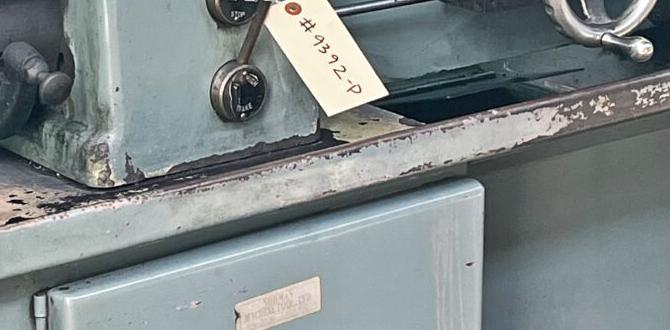Achieve a brilliant, mirror-like brass finish using a carbide end mill with our simple guide. Learn the best speeds, feeds, and techniques to make your brass projects shine like never before.
Have you ever struggled to get that perfect, shiny finish on brass parts using your milling machine? It’s a common frustration! Achieving a true mirror polish on brass can seem like a dark art, leaving many beginners feeling inadequate. But it doesn’t have to be that way. With the right tools and a few key techniques, getting a dazzling brass mirror finish is well within your reach, even with a carbide end mill. This guide will walk you through everything you need to know, step-by-step, so you can confidently tackle your next brass project and achieve results you’ll be proud of. Let’s dive in and uncover the secrets to a gleaming brass surface!
We’ll cover selecting the right end mill, setting up your CNC or manual mill, understanding cutting parameters, and the crucial finishing passes that make all the difference. Get ready to transform your brass!
Understanding the Carbide End Mill for Brass
A carbide end mill might not be the first tool that comes to mind when you think about delicate finishing, especially on softer metals like brass. We often associate them with tougher materials and heavy-duty material removal. However, modern carbide end mills, particularly those designed for non-ferrous metals, are exceptionally well-suited for achieving a superb surface finish on brass when used correctly. Their hardness and ability to hold a sharp edge are key, but it’s how you employ them that unlocks their finishing potential.
Brass, being a relatively soft alloy of copper and zinc, can be prone to “gumming up” or loading in cutting tools. This is where the properties of a carbide end mill truly shine. Unlike high-speed steel (HSS), carbide resists the higher temperatures generated during cutting, which can be beneficial even at finishing speeds and feeds. Moreover, a sharp carbide edge will cut rather than drag, leading to a cleaner surface. For that sought-after mirror finish, the focus shifts from aggressive material removal to gentle, precise cutting that burnsishes the surface.
Why Brass is Tricky (and How Carbide Helps)
Brass’s composition means it can be ductile and sticky. When machined aggressively, chips can weld themselves to the cutting edge, leading to a poor finish, tool breakage, and frustration. This is often why many recommend HSS for brass or even specialized plastics cutters. However, the “gumming” effect is minimized when you use:
- A very sharp cutting edge.
- The correct geometry on the end mill (specifically designed for non-ferrous materials).
- Appropriate cutting speeds and feed rates.
- A high-quality lubricant or coolant.
Carbide end mills, especially those with a high polish on their flutes and a sharp, finely honed edge, are engineered to address these issues. They maintain their sharpness longer and resist built-up edge (BUE) better than HSS, making them ideal for achieving a smooth, reflective surface when the conditions are right.
Selecting the Right Carbide End Mill
Not all carbide end mills are created equal, especially when aiming for a mirror finish on brass. The devil is in the details: flute count, geometry, coating, and tolerance. For a brilliant finish, we’re not looking for a roughing end mill. We need something capable of delicate, precise cuts.
Key Features to Look For:
- Number of Flutes: For finishing, fewer flutes are generally better.
- 2-Flute: Excellent for soft, gummy materials like brass and aluminum. The larger chip clearance helps prevent clogging and buildup. This is often your best bet for a mirror finish.
- 3-Flute: Can also work, offering a bit more rigidity, but might require slightly higher feed rates to prevent chip recutting.
- 4-Flute and Up: Generally too many flutes for finishing soft metals, leading to increased chip load per tooth and potential for clogging. Reserved for harder materials or heavy roughing.
- Geometry:
- Bright Finish/Uncoated: Often preferred for brass. A polished flute surface reduces friction and chip adhesion.
- Polished Flutes: Even if coated, the flutes should be highly polished.
- Sharp Edges: Look for end mills with a fine, sharp cutting edge. Some specialized finishing end mills have a slight radius or hone on the cutting edge, which can help achieve a burnishing effect.
- Up-cut vs. Down-cut vs. Ball End Mill: For flat surfaces, a standard two-flute, potentially an ‘up-cut’ to help evacuate chips upwards (if your setup allows), or even a very fine ‘ball end mill’ can provide an exceptionally smooth finish by “sweeping” the surface. However, for most general flat finishing, a sharp, two-flute, straight-cut, polished end mill is the workhorse.
- Material: Solid carbide is the standard. Look for high-performance grades suitable for non-ferrous materials.
- Shank: Ensure the shank fits your collet or tool holder securely. For precision, a well-ground shank is crucial.
- Length: For specific applications, a “long reach” end mill might be needed to get into certain areas without collisions. The keyword mention of “carbide end mill 1/8 inch 3/8 shank long reach for brass mirror finish” highlights a specific type. A 1/8 inch diameter is very fine, excellent for intricate work and detail finishing, while the 3/8 inch shank offers good rigidity for that size. “Long reach” implies extended flute length, which needs careful consideration regarding rigidity and potential vibration.
Recommended End Mill Type for Brass Mirror Finish:
For that ultimate brass mirror finish, I typically reach for a high-quality, uncoated, solid carbide, two-flute end mill with highly polished flutes. The polished flutes are non-negotiable as they minimize friction and prevent brass from sticking. A fine edge, potentially with a very slight hone, is also beneficial. The diameter will depend on your workpiece, but for detail and smooth passes, smaller diameters like 1/8 inch can be excellent.
Setting Up Your Machine for Success
Getting a mirror finish isn’t just about the tool; your machine setup plays a massive role. Precision and rigidity are paramount. Any slop or vibration will show up as imperfections on your brass surface.
Machine Rigidity and Cleanliness:
Ensure your milling machine (whether CNC or manual) is in good working order. Check for:
- Tight Spindle Bearings: No play whatsoever.
- Rigid Workholding: Your brass part must be held down rock-solid. Use clamps, vises, or fixtures that don’t allow any movement during the cut. Even a tiny shift can ruin a finish.
- Clean Spindle and Tool Holders: Debris can cause runout, leading to a poor finish.
- Proper Tool Holder: Use a quality collet or tool holder that grips the shank of the end mill uniformly and minimizes runout. A precision collet is highly recommended.
Speeds and Feeds: The Sweet Spot for Brass
This is where a lot of the magic happens. Brass benefits from relatively high speeds but requires careful feed rates to avoid chip welding. The goal is to shear the material cleanly, not rub or drag.
As a starting point for a polished two-flute carbide end mill on brass, consider these parameters (these are general guidelines, always test on scrap first!):
| Parameter | Typical Value for Brass Mirror Finish | Notes | |
|---|---|---|---|
| Surface Speed (SFM) | 250 – 600 SFM | Higher speeds help manage heat and prevent chip welding. | |
| Spindle Speed (RPM) | Calculate based on SFM and tool diameter Example for 1/8″ (0.125″) end mill: RPM = (SFM 3.82) / Diameter RPM = (400 3.82) / 0.125 = 12,224 RPM |
Use a spindle capable of high RPMs. | |
| Feed Rate (IPM) | 0.0005 – 0.002 inches per tooth (IPT) | This is crucial. Start low and increase if chips are clearing well. For 1/8″ dia, 2-flute: Feed per minute = IPT Flutes RPM Feed per minute = 0.001 2 12,224 = 24.4 IPM |
Keep chip load per tooth very small for finishing. |
| Depth of Cut (DOC) | 0.001″ – 0.005″ | Very shallow cuts are key for a mirror finish. | |
| Width of Cut (WOC) | 25% – 75% of tool diameter | For finishing passes, aim for consistent overlap. |
Important Notes on Speeds and Feeds:
- Chip Load Per Tooth (IPT): This is arguably the most critical factor for finishing. A lower IPT ensures the tool is shearing the material cleanly rather than rubbing or gouging, and it helps prevent chip welding. For a mirror finish, you want it very light.
- Recalculate: Always recalculate RPM and Feed Rate based on YOUR specific end mill diameter and desired surface speed. Online calculators exist for this (e.g., Haas Machining Calculator provides useful formulas).
- Listen to the Machine: Pay attention to the sound of the cut. A smooth, consistent hum is good. A chattering or grinding sound indicates problems—usually too aggressive a feed, too deep a cut, or tool/workpiece vibration.
- Lubrication/Coolant: A flood coolant system or even a mist coolant (like WiseCut Mist Coolant Systems) is highly recommended for brass to keep chips from welding and to cool the tool. A cutting fluid specifically for aluminum and brass can also make a significant difference.
The Step-by-Step Process for a Mirror Finish
Achieving that perfect brass mirror finish is a multi-stage process. It involves preparation, careful cutting, and a final burnishing pass. Don’t rush any of these steps!
Step 1: Preparation is Key
- Clean Your Workpiece: Ensure the brass is free from dirt, oil, or any contaminants.
- Secure Workholding: Mount your brass part extremely securely in your vise or fixture. Minimal overhang is best.
- Zero Your Machine: Accurately set your X, Y, and Z zero points.
Step 2: Roughing Pass (If Necessary)
If your part isn’t already close to its final dimensions, it’s often best to do a roughing pass first with a general-purpose end mill (carbide or HSS). This removes the bulk of the material. For brass, a two or three-flute end mill can work well here. Use moderate speeds and feeds with a decent depth of cut. Flood coolant is very helpful at this stage.
Step 3: Semi-Finishing Pass
Once you’re within about 0.010″ to 0.020″ of your final dimensions, switch to your dedicated finishing end mill (the polished two-flute carbide we discussed). This pass cleans up the bulk of the material, leaving a smooth, consistent surface that’s ready for the final polish.
- Use the speeds and feeds recommended above, possibly slightly more aggressive than the final polish pass.
- A shallow depth of cut (e.g., 0.005″ – 0.010″) and a moderate width of cut (e.g., 50% of tool diameter).
- Ensure excellent chip evacuation.
Step 4: The Mirror Finish Pass (The “Burnish”)
This is the critical step. The goal here is not aggressive material removal, but rather to “burnish” or polish the surface using the sharp edge of your carbide end mill.
- Tool: Use your pristine, polished two-flute carbide end mill. Ensure it’s perfectly clean and has no built-up material.
- Surface Speed: Aim for the higher end of the recommended SFM range (e.g., 400-600 SFM). This means a higher RPM for your spindle.
- Feed Rate: This is paramount. Use a very low chip load per tooth (e.g., 0.0005″ – 0.001″ IPT). This translates to a very fine feed rate per minute (IPM).
- Depth of Cut: Extremely shallow! Think 0.001″ to 0.003″. You want to be barely grazing the surface, removing just enough material to smooth out micro-imperfections.
- Width of Cut: Use a consistent stepover, somewhere between 25% and 75% of the tool diameter. A larger stepover will leave visible “climb marks” or scallops, while a smaller stepover will create a smoother, more uniform finish. For a true mirror finish, you might even consider a very small stepover (e.g., 10-20% on the final pass, or use a ball end mill that sweeps).
- Lubrication: A good quality cutting fluid or mist coolant is essential to prevent any sticking and to maintain a clean cut.
- Direction: For CNC, ensure your toolpath is optimized for surface finish. Climb milling typically produces a better finish than conventional milling.
Step 5: Post-Machining Polish (Optional but Recommended)
Even after the best milling pass, you might see faint tool marks or have tiny imperfections. For a true show-quality mirror finish:
- Clean Thoroughly: Remove all coolant, chips, and debris.
- Light Hand Polishing: Use a high-quality metal polish (like Autosol or Simichrome) with a soft cloth. Work in a consistent direction.
- Buffing: For ultimate shine, a final buff with a soft buffing wheel and polishing compound on a separate tool (or carefully on the lathe if applicable) can achieve a dazzling result.
Tools and Materials Checklist
Here’s a quick rundown of what you’ll need to succeed:
| Item | Description/Notes |
|---|---|
| CNC or Manual Milling Machine | Rigid and capable of high spindle speeds. |
| Solid Carbide, 2-Flute End Mill | Uncoated or bright finish, highly polished flutes. Example: 1/8 inch diameter, carbide end mill, 3/8 inch shank, long reach (if needed) for brass mirror finish. |
| Precision Collet/Tool Holder | To minimize runout. |
| Secure Workholding | Vise, clamps, or fixture. |
| Quality Cutting Fluid/Mist Coolant | Specifically for non-ferrous metals, or a general-purpose fine finish fluid. |
| Safety Glasses & Hearing Protection | Always! |
| Chip Brush/Vacuum | For cleaning. |
| Soft Cloths | For cleaning and polishing. |
| Metal Polish | High-quality brand (e.g., Autosol, Simichrome). |
| Scrap Brass | For testing speeds, feeds, and cuts. |
Common Issues and Troubleshooting
Even with the best setup, you might encounter problems. Here’s how to fix them:
Issue: Built-Up Edge (BUE) / Chip Welding
- Cause: Not enough coolant, incorrect speeds/feeds (too slow), dull tool, or gummy brass alloy.
- Solution:
- Increase coolant flow or use a better coolant.
- Increase surface speed (RPM).
- Slow down feed rate (IPT).
- Ensure your end mill is




